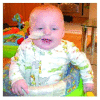Sodium channel myotonia may be associated with high-risk brief resolved unexplained events
- PMID: 32509969
- PMCID: PMC7241273
- DOI: 10.12688/wellcomeopenres.15798.2
Sodium channel myotonia may be associated with high-risk brief resolved unexplained events
Abstract
Brief resolved unexplained events (BRUEs) have numerous and varied causes posing a challenge to investigation and management. A subset of infants with the neuromuscular disorder sodium channel myotonia, due to mutations in the SCN4A gene, experience apnoeic events due to laryngospasm (myotonia) of the upper airway muscles that may present as a BRUE. We sought to ascertain the frequency, severity and outcome of infants carrying the G1306E SCN4A mutation commonly associated with this presentation. We report 14 new cases of individuals with the G1306E mutation from three unrelated families and perform a literature review of all published cases. Infants with the G1306E mutation almost universally experience laryngospasm and apnoeic events. The severity varies significantly, spans both low and high-risk BRUE categories or can be more severe than criteria for a BRUE would allow. At least a third of cases require intensive care unit (ICU) care. Seizure disorder is a common erroneous diagnosis. Apnoeas are effectively reduced or abolished by appropriate treatment with anti-myotonic agents. Probands with the G1306E mutation who are family planning need to be counselled for the likelihood of post-natal complications. There is readily available and extremely effective treatment for the episodic laryngospasm and apnoea caused by this mutation. Proactively seeking clinical evidence of myotonia or muscle hypertrophy with consideration of CK,EMG and genetic testing in high risk BRUEs or more complex apnoeic events may reduce avoidable and prolonged ICU admissions, patient morbidity and potentially mortality.
Keywords: Apnoea; Channelopathy; Laryngospasm; Muscle Disease; Myotonia; Paediatric; Sodium channel; Stridor.
Copyright: © 2020 Cea G et al.
Conflict of interest statement
No competing interests were disclosed.
Figures



Similar articles
-
Myotonia permanens with Nav1.4-G1306E displays varied phenotypes during course of life.Acta Myol. 2017 Sep 1;36(3):125-134. eCollection 2017 Sep. Acta Myol. 2017. PMID: 29774303 Free PMC article.
-
New phenotype of severe neonatal episodic laryngospasm due to a missense mutation in SCN4A: A case report and literature review.Zhong Nan Da Xue Xue Bao Yi Xue Ban. 2021 Dec 28;46(12):1430-1436. doi: 10.11817/j.issn.1672-7347.2021.200598. Zhong Nan Da Xue Xue Bao Yi Xue Ban. 2021. PMID: 35232915 Free PMC article. Review.
-
Diagnosis and outcome of SCN4A-related severe neonatal episodic laryngospasm (SNEL): 2 new cases.Pediatrics. 2013 Sep;132(3):e784-7. doi: 10.1542/peds.2012-3065. Epub 2013 Aug 19. Pediatrics. 2013. PMID: 23958773
-
Possible role of SCN4A skeletal muscle mutation in apnea during seizure.Epilepsia Open. 2019 Jul 1;4(3):498-503. doi: 10.1002/epi4.12347. eCollection 2019 Sep. Epilepsia Open. 2019. PMID: 31440732 Free PMC article.
-
Flecainide-Responsive Myotonia Permanens With SNEL Onset: A New Case and Literature Review.Pediatrics. 2016 Apr;137(4):e20153289. doi: 10.1542/peds.2015-3289. Epub 2016 Mar 4. Pediatrics. 2016. PMID: 26944947 Review.
Cited by
-
Targeted Therapies for Skeletal Muscle Ion Channelopathies: Systematic Review and Steps Towards Precision Medicine.J Neuromuscul Dis. 2021;8(3):357-381. doi: 10.3233/JND-200582. J Neuromuscul Dis. 2021. PMID: 33325393 Free PMC article.
-
Ion Channel Gene Mutations Causing Skeletal Muscle Disorders: Pathomechanisms and Opportunities for Therapy.Cells. 2021 Jun 16;10(6):1521. doi: 10.3390/cells10061521. Cells. 2021. PMID: 34208776 Free PMC article. Review.
References
Publication types
Grants and funding
LinkOut - more resources
Full Text Sources
Research Materials

